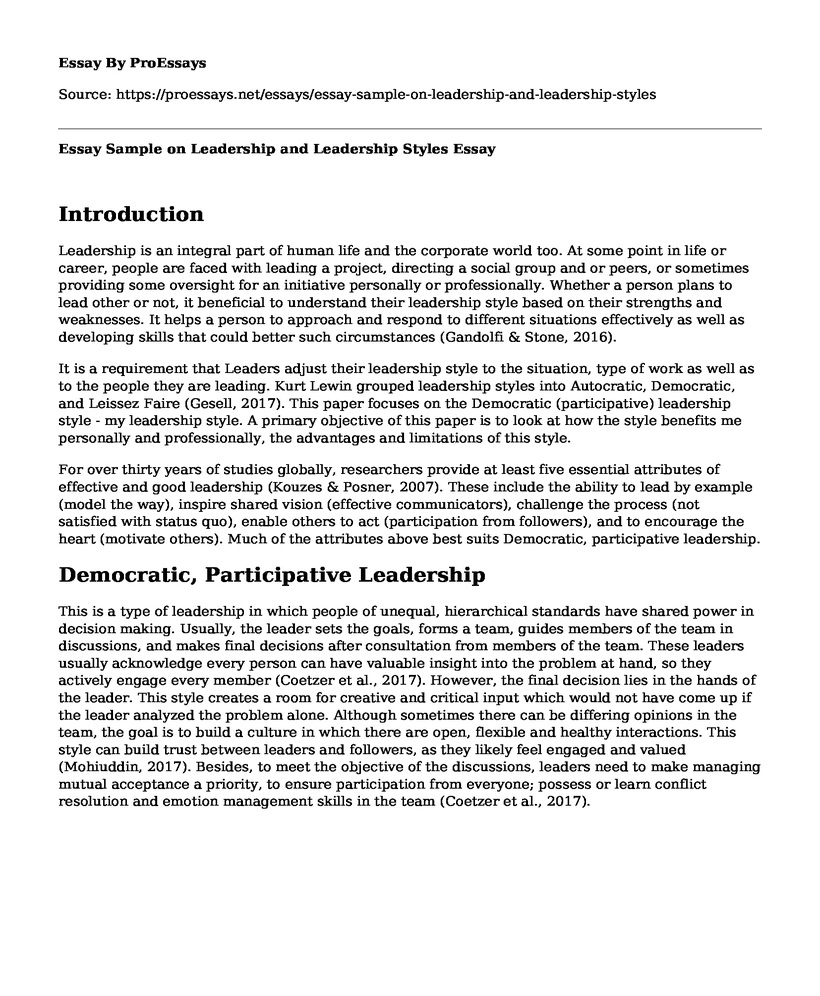Introduction
Leadership is an integral part of human life and the corporate world too. At some point in life or career, people are faced with leading a project, directing a social group and or peers, or sometimes providing some oversight for an initiative personally or professionally. Whether a person plans to lead other or not, it beneficial to understand their leadership style based on their strengths and weaknesses. It helps a person to approach and respond to different situations effectively as well as developing skills that could better such circumstances (Gandolfi & Stone, 2016).
It is a requirement that Leaders adjust their leadership style to the situation, type of work as well as to the people they are leading. Kurt Lewin grouped leadership styles into Autocratic, Democratic, and Leissez Faire (Gesell, 2017). This paper focuses on the Democratic (participative) leadership style - my leadership style. A primary objective of this paper is to look at how the style benefits me personally and professionally, the advantages and limitations of this style.
For over thirty years of studies globally, researchers provide at least five essential attributes of effective and good leadership (Kouzes & Posner, 2007). These include the ability to lead by example (model the way), inspire shared vision (effective communicators), challenge the process (not satisfied with status quo), enable others to act (participation from followers), and to encourage the heart (motivate others). Much of the attributes above best suits Democratic, participative leadership.
Democratic, Participative Leadership
This is a type of leadership in which people of unequal, hierarchical standards have shared power in decision making. Usually, the leader sets the goals, forms a team, guides members of the team in discussions, and makes final decisions after consultation from members of the team. These leaders usually acknowledge every person can have valuable insight into the problem at hand, so they actively engage every member (Coetzer et al., 2017). However, the final decision lies in the hands of the leader. This style creates a room for creative and critical input which would not have come up if the leader analyzed the problem alone. Although sometimes there can be differing opinions in the team, the goal is to build a culture in which there are open, flexible and healthy interactions. This style can build trust between leaders and followers, as they likely feel engaged and valued (Mohiuddin, 2017). Besides, to meet the objective of the discussions, leaders need to make managing mutual acceptance a priority, to ensure participation from everyone; possess or learn conflict resolution and emotion management skills in the team (Coetzer et al., 2017).
Advantages and Limitations
This sections will look at both advantages and disadvantages of Participative leadership style.
Advantages
As mentioned in the previous sections, this style can build trust between the leader, and his followers. The followers get engaged and therefore feel valued. As a result, they give their best in their areas of assignment hence high quality and quantity of output. Also, there is high employee retention, few cases of absenteeism due to job satisfaction. Lastly, it reduces the chances of accidents in the workplace. This is possible because usually right people are assigned to right tasks based on the group assessment of the tasks at hand, the leader knowing strengths and weaknesses of each member of the team, and guiding the team through the processes while addressing any concern. Best decisions and choices are made due to the thought process of problem-solving and decision making.
Limitations
Involving every member of the team in decision making makes the process slow, and therefore the style is not suitable for high-pressure situations like crisis times. Since every member is involved in decision making, lack of expertise in the team can hinder arriving at the best decisions. Also, Conflicts and disagreements are common scenarios especially if contributions from some members are not taken when they provide different opinions.
Conclusion
This paper provided a brief introduction to leadership and leadership styles by Kurt Lewin and focused on Democratic leadership which is my best style of leadership, a summary of its importance, advantages, and limitations. Democratic leadership might be applicable in many spheres of life, but leaders are usually advised to adjust to situations and group of people to be led for effective leadership.
References
Coetzer, M., F., Bussin, M., & Geldenhuys, M. (2017). The functions of a servant leader. Administrative Sciences (2076-3387), 7(1), pp. 1-32.
Gandolfi, F., and Stone, S. (2017). The emergence of leadership styles: A clarified categorization. Revista De Management Comparative International, 18(1), pp. 18-30.
Gesell, L., (2017). Understanding your leadership style. Retrieved from: https://www.lynda.com/Business-Skills-tutorials/Understand-your-leadershipstyle/427474/593626-4.html
Mohiuddin, Z.A. (2017). Influence of leadership style on employee performance: Evidence from literature. Journal of Marketing and Management, 8(1), 18-30.
Cite this page
Essay Sample on Leadership and Leadership Styles. (2022, Nov 08). Retrieved from https://proessays.net/essays/essay-sample-on-leadership-and-leadership-styles
If you are the original author of this essay and no longer wish to have it published on the ProEssays website, please click below to request its removal:
- Responsibilities of Managers and Leaders Essay Example
- Sustainable Change Essay Example
- Ethical Dilemma in Facebook Inc.
- Essay Sample on Crisis: Definition, Root Causes, and Impacts
- Enhancing Group Functioning: Changes for Better Outcomes - Essya Sample
- Essay Example on Developers' Plumbing Needs: Aqualisa Quartz's ShowerMax Product
- Paper Example on Educational Technology: Empowering Individuals to Live Better in Society







